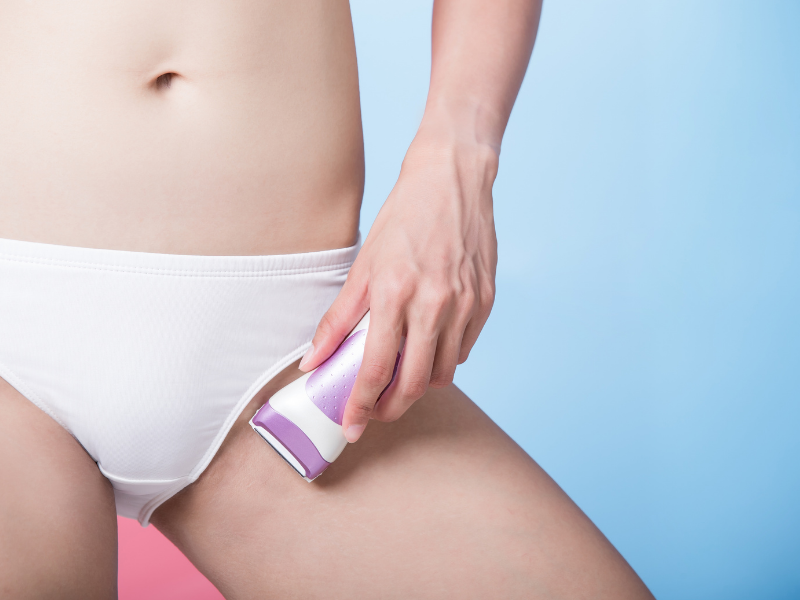/assets/images/provider/photos/2499128.png)
How to Treat Razor Bumps in the Pubic Area
You think you’ve just finished shaving your pubic area, but you notice something. It’s red, itchy, and painful. You have a razor bump in your pubic area.
Razor bumps are common for many people who shave the sensitive skin of their genitals, so if you’re dealing with them, don’t beat yourself up about it. If you get a case of razor bumps around the pubic area, you can treat it right away and take steps to prevent future razor bumps.
Here’s how to treat razor bumps in the pubic area once they pop up (and how to prevent them in the first place).

How do you get razor bumps in the pubic area?
Razor bumps are small, red bumps that can appear after shaving. They’re called “razor bumps” because ingrown hairs from shaving cause them. These bumps develop when hair shafts become trapped beneath the skin’s surface. Ingrown hairs can be painful, itchy, and embarrassing, especially in a sensitive area like your pubic region!
Are razor bumps common in the pubic area?
Yes! If you’ve ever shaved or waxed the areas around your genitals, you’re at risk of getting razor bumps. The good news is that if you follow these tips for preventing razor bumps in the future, they’ll be less likely to appear on your body again.
How to prevent razor bumps in sensitive areas
- Avoid shaving for at least 48 hours after having sex (to let any cuts heal).
- Use a sharp razor instead of pressing the razor hard for a close shave.
- Apply plenty of moisturizer after shaving.
These tips will help keep your skin in good condition and hopefully prevent problems from razor bumps.
How to treat razor bumps in the pubic area
If you already notice a red, bumpy rash on your skin, it is too late for prevention. It’s time to focus on treatment.
Make sure to wash the area gently with warm water and soap each day. That will help to cleanse your skin and prevent infection.
Apply a topical cream that soothes razor burn or ingrown hairs, such as aloe vera gel or witch hazel solution.
Apply a warm compress to the affected area for 10 minutes, up to three times per day, to increase blood flow to the area.
If your symptoms don’t go away or become worse, talk to a doctor about other treatments or prescription medications.
Tips for preventing razor bumps in the pubic area in the future
- Use a good-quality razor. A dull blade will cause the hair to be pulled out at the surface, causing irritation and ingrown hairs.
- Shave in the direction of hair growth, not against it.
- Shave after you shower or bathe so that there’s plenty of moisture on your skin, which will help open up pores and provide lubrication to prevent irritation while shaving. It’s also important to shave with warm water (not hot) since hot water can cause skin irritation in this area too!
- Always moisturize afterward—you may find that applying some baby oil helps significantly!
If you get razor bumps, treat them right away and take steps to prevent them from coming back.
If you get razor bumps, treat them right away and take steps to prevent them from coming back.
- Get your skin prepared. Before shaving or waxing, exfoliate (gently rub) the area with a loofah or body brush in warm water to remove dead surface skin cells. It will help prevent ingrown hairs and bumps. You can also use an over-the-counter preparation like Tend Skin® Liquid or Tend Skin® Shave Gel to reduce irritation after shaving or waxing.
- Use a sharp razor when trimming pubic hair, so you don’t cut yourself or irritate sensitive areas with dull blades on shaves that are too close together. It’s also important not to shave more than once every day—this can increase irritation and make it harder for the hair to grow back evenly because it takes time for new growth from old follicles to emerge from under existing stubble before being visible again at surface level.”
Conclusion
Razor bumps are no fun, but they’re also nothing to be embarrassed about. Lots of people get them, and you can take steps to prevent them and treat them. Now that you know how razor bumps form and some tips for getting rid of them, give the methods we covered a try!
If you try to relieve razor bumps on your own, but they won’t go away, it’s time to talk to a medical professional.
Learn More
If razor bumps have you bothered and you want to talk to an online doctor, Razor Bumps, Inc.’s board-certified physicians are available now through easy virtual video visits. Find out more by chatting with us now.
Disclaimer: The contents of this article are for informational purposes only and do not constitute medical advice. The information, graphics, and images on this site are not intended to substitute diagnosis or treatment by a medical professional. Always seek the advice of a licensed physician for any questions you may have regarding a specific condition.